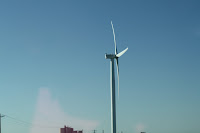De Immigrant
De Immigrant: By Donation
10th Avenue and 1st Street
Fulton, Illinois.
(815) 589-4545
Stairways lead up into the windmill. Access to the windmill can also be reached by walkways on the top of the dike. The windmill is partially handicap accessible.
May (Weekends Only)
Saturday: 10:00am – 5:00pm, Sunday: 1:00pm-5:00pm
Memorial Day thru August 31:
Monday through Saturday: 10:00am – 5:00pm, Sunday 1:00pm-5:00pm
September 1 thru 1st weekend in October:
Monday through Friday: 10:00am-3:00pm, Saturday: 10:00am-5:00pm, Sunday: 1:00pm – 5:00pm
Remaining Weekends in October:
Saturday: 10:00am - 5:00pm, Sunday: 1:00pm - 5:00pm
Windmills have been around to harness power for various reasons for centuries. Until the twentieth century, they looked very much the same—probably the same style Don Quitote saw in his quest. New windmills (called turbines) generally are used to harness power to produce electricity. But the concept is the same—turn wind into useful energy. Here in Florida, we are not likely to see very many. The major alternative source of power is solar.
In New York state and throughout the Midwestern states of Nebraska, Wyoming, Iowa and Minnesota, however, we have seen hundreds of the new modern style. Wind “farms” have become popular in many parts of the country for several reasons. It is “green”—good for the environment and highly profitable. Companies pay farmers to use their land to put up the big three-pronged propeller. The farmer can still use his land for growing crops, cattle or for whatever he used his land before the wind turbines. A wind farm is a group of wind turbines—from a handful to several hundred--in the same location used for production of electric power. Each turbine is interconnected with a power collection system and communications network. Electrical current in the form of a medium voltage is forwarded to a substation, converted into higher voltage through a transformer which then sends it through a high voltage transmission system.
These farms are great, but do not hold the character and romanticism of the type we remember of yesteryear. Holland is the place that comes to mind when we think of these marvelous miracles, although they have been used in America as well.
In the town of Fulton, Illinois, the large Dutch population ordered a windmill which they call de Immigrant. Built and pre-assembled in the Netherlands, it is located on the Mississippi River—on a flood dike high above the River. Dutch masons and craftsman came with the windmill to assemble it. Dedicated in 2000.
The Dutch used various windmills for different jobs. Paint mills where various items were ground (including some insects) to produce various colors. Other mills were used to grind peanuts and linseed to process the oils from them to be used in all kinds of jobs in daily life.
When we were there, two millers and an apprentice were working. The apprentice was a lad of about eleven to thirteen. He did everything the millers did. All are volunteers.
When we were there, two millers and an apprentice were working. The apprentice was a lad of about eleven to thirteen. He did everything the millers did. All are volunteers.
This particular windmill produced energy to grind grains—corn, various types of wheat, rye and buckwheat—a whole montage of grains. One miller showed samples of various grains ground. Also, the same grain can be ground into different consistencies or fineness. No preservatives. It needs to be used moderately soon or refrigerated.
Even though it was almost closing time, we had a comprehensive tour. Steve and Rich went to the very top of the windmill in the company of the second miller and the apprentice. The millers only allowed two folks at a time on this venture at a time. There were two other women, who wanted to go to the top, as well. Apparently, this extra portion of the tour is rare, but a miller will guide one or two people to the top if the time is close to the end of the day. (Rich has been up to the top at least twice). Since I seemed to be the odd-man-out, I sacrificed my chance, but maybe another time. The entire windmill (with a few exceptions) is made of wood…many kinds. The exceptions, of course, are the canvas on the sails, the grinding stones, iron for the brakes and tie down areas and a couple of other minor odds and ends.
The miller explained the grinding process in detail. He also gave a great deal of detail about the way the grinding stones work, how they keep the windmill from moving if they are not there (it has what seems like a simple braking system, but it felt much more complicated after the miller explained its dynamics) and the way the wind turns the sails.
Mid summer is not the time for tulips, but the edge of the property on the ridge above the River there were massive amounts of beautiful black-eyed Susans. On a dreary day, such as it was on the day we visited, it brought its own brand of sunshine.
One could do a dash-through in a few minutes or take time to listen to the millers. They are well versed in their knowledge of the history, operation, building and detail of the windmill. A thoroughly educational and entertaining time.
Across the street is a store/gift shop which sells various Dutch style decorations, crafts and the grain ground at the windmill.
This experience was a lot of fun.






No comments:
Post a Comment